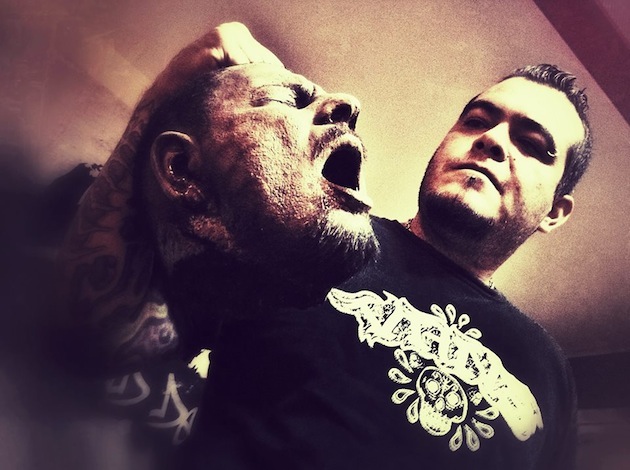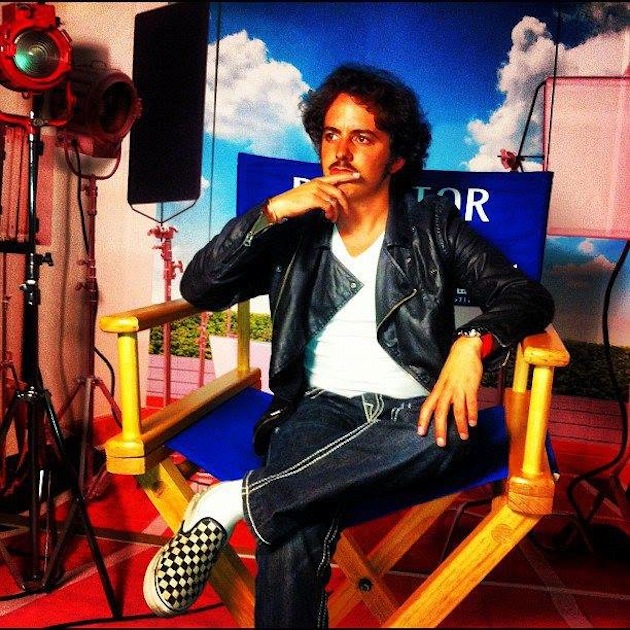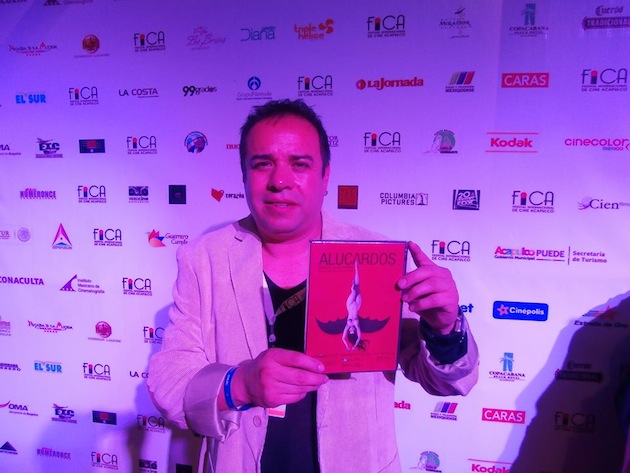MEXICO BARBARO Exclusive Interview: Six Directors, Including Lex Ortega And Isaac Ezban, Talk Horror Anthology
As our own Andrew Mack reported, México Bárbaro is an upcoming Mexican horror anthology featuring cinematic adaptations of traditional legends from this country. It was conceived by Lex Ortega (sound designer for Frankenstein's Army) and will be offering segments by such directors as Somos Lo Que Hay's Jorge Michel Grau, Alucardos, Retrato de un Vampiro's Ulises Guzmán, and The Incident's Isaac Ezban.
The anthology instantly became one of the most anticipated and promising Mexican films of the year. I had the fortune and honor to interview for ScreenAnarchy six of the eight directors involved: Ortega, Guzmán, Ezban, Rue Morgue's Aaron Soto, M is for Matador's Gigi Saúl Guerrero and Babtized's Laurette Flores. In the gallery below you can read each interview and learn more about México Bárbaro, teamwork, the directors' influences and what their segments are more or less about.
Many thanks to the directors for their time.







Lex Ortega
ScreenAnarchy: You organized the MÉXICO BÁRBARO project. How did the idea emerge?
Lex Ortega: I dare to say it is almost “impossible” to watch short films regularly at movie theater chains. Luckily, shorts are always welcomed at festivals and they have their own space. Unfortunately, their life span is relatively brief and you can only watch them at festivals or special showings.
The idea of making an anthology comes because of that, in order to give a bigger life span to the short film and a larger scale projection.
This won’t be your first work on an anthology (thinking in THE ABCS OF DEATH and BEWARE! BODY COUNT). Classic horror anthologies like CREEPSHOW and BLACK SABBATH, or most recent ones like TRICK ‘R TREAT and V/H/S, are an influence for you?
Creepshow influenced this project very much, but there’s other anthology that definitely put me in the territorial context, which is the vertebral column of México Bárbaro. I’m talking about Three… Extremes, made by several Asian directors (Miike Takashi, Fruit Chan and Chan-wook Park). My perception of that film is that they tell stories in a very local way and I loved that.
Did you manage to reunite all the directors you had in mind since the beginning?
The majority of the initial filmmakers are the ones reunited today, although the original list of possible directors changed a bit because two were busy filming other things and decided to step out of the project for personal reasons. When that happened, we proposed privately their conceivable successors, analyzed their works and made the decision after voting.
I did the selection based on directors I admire. We met at genre festivals and showings, while we were showing our works. Everyone has contributed to the project with amazing stuff and, I think, the most important thing is the great interest they all have. The decision of creating without excuses, just filming and telling stories with nothing stopping us.
Can you tell more about your MÉXICO BÁRBARO segment?
My segment is titled It’s the Inside What Matters (Lo Que Importa Es Lo de Adentro). It is a bizarre, sick and very violent version of what we know as “el Coco” o “el Señor del Costal” (the Hispanic equivalent of the bogeyman). It has an urban setting, very close to any of us who live in the monster of a city that Mexico City is.
I interview recently José Luis Ortega, Mauricio Matamoros and Jorge Grajales (experts and programmers from Mexico). When I asked them about the current genre scene in Mexico, three names standed out: Jorge Michel Grau, Isaac Ezban and yours, Lex Ortega. Thinking in this, what does MÉXICO BÁRBARO means to Mexican genre cinema?
It is a film that shows the world different visions of Mexican traditions and legends but, most importantly, is the context of being a collective and plural project.
We want to expand México Bárbaro like a franchise, to give opportunities to more male and female genre directors from all over Mexico. It won’t matter if their career is long or short. The only requirement is to be Mexican born, though it doesn’t matter their current place of residence.
We also want to open a forum and platform through social networks, where film professionals and suppliers who are interested in horror and fantasy cinema will be able to show and offer their work. A self-management medium to generate projects, offer advice and support exercises done outside the franchise.
That is our main contribution to Mexican genre cinema and what makes México Bárbaro the first film with this characteristics in the country.
Isaac Ezban
ScreenAnarchy: How was you first approach to the project?
Isaac Ezban: I make horror and science fiction films. I’m a fan of these genres and that is the kind of cinema I want to do my whole life. Besides having made several horror and science fiction short films, I just wrapped the filming of my debut feature, the science fiction film The Incident (El Incidente), which won best script at the Guanajuato International Film Festival and best project presentation at Fantastic Fest’s Fantastic Market. Now we are working on the post-production.
My first approach to México Bárbaro came because I know Lex Ortega very well ever since I was with him at the Morbido Film Festival. I’m a huge fan of his work and he is doing the sound design for The Incident, through his company LSD. He invited me to this project and I loved that because I adore horror anthologies, like The ABCs of Death and V/H/S, and I always wanted to be part of one. I see México Bárbaro as a great opportunity to grow as a director and be part of an anthology together with directors I love and admire.
Tell me more about your segment.
The idea of having each director choosing a different legend wasn’t filming it in a literal way but rather adapting the legend to modernity, and that is exactly what I’m going to do with my segment.
I chose the legend of the Alushes, these trolls that hide in the jungle or the forest, mostly near the Mayan Riviera, and steal you stuff. However, in the original legend the Alushes are not really evil, they are just naughty; they can steal your toothbrush if you are camping, for instance. This is why I decided to re-adapt the story and make it a little more twisted. In my story the Alushes are real monstrous and terrifying trolls and they will not only steal an insignificant object… they will steal something very important: a girl’s virginity!
My segment is called The Most Precious Thing (La Cosa Más Preciada) and it is about a couple of teenagers that travel one night to a cabin in the woods to lose their virginity, without knowing that the alushes live there. I can say in advance that my segment will be very visual and graphic, more than anything I have done before. I chose this legend and story because I love movies with transgenic mutations, a la David Cronenberg. I also like to talk with metaphors related to sexuality and the point is combining these two elements: sexuality and something mutant and horrifying. With my medium-length film Nasty Stuff (Cosas Feas), I did something visually similar.
Sexuality is something a bit bizarre so I like to exaggerate things and make everything weirder. In addition, with this story I’m trying to pay homage to B movies of the seventies and eighties and to slashers in which the teenagers who have sex are punished by the script.
How has the teamwork between the directors been so far?
So far it has been great. Like I told you, I already knew Lex (Ortega), as well as the majority of the other directors. I have known Jorge Michel (Grau) for years, since I watched Somos Lo Que Hay. I met Edgar Nito at the Fantastic Fest, where he also pitched a project and won the third place. I have been in touch with Aaron Soto through social networks for years but I haven’t met him in person.
With this project, I met personally for the first time Ulises (Guzmán), Gigi (Saul Romero) and Laurette (Flores). They are all nice people and what I like the most is that all of them are really crazy; each story is weirder than the other, and I feel in home. I’m also excited to see the great variety of legends. Variety in every way: period, setting, style and story. And not everyone lives in Mexico City, which is also a really good thing as there is representation from other parts of the country and also of both sexes. Everyone is working hard and something great will come out.
Ulises Guzmán
ScreenAnarchy: How was you first approach to the project?
Ulises Guzmán: This is really a project that emerges from Lex Ortega’s initiative. He invited me directly. The truth is I got really excited when he talked to me about it and the people who were involved in it. He mentioned the filmmakers that are part of it right now but also the names of others who couldn’t participate.
His enthusiasm was contagious and while it is not a novel way to make a film, in today’s Mexico it turns to be very provocative and revolutionary. Let me explain why…
The invitation is strange. He is not inviting you to a production already financed but instead this is a challenge for everyone in order to reunite the resources for each short film. And well, that is the habitual but the potential that this way of producing has is the option of forming a front if you put together several factions doing the same separately. The invitation resulted in the rumor spreading quickly and today there are a more than twelve directors, of different origin, age and experience, very excited, wanting to make a short film and unite efforts. Not to mention the countless people who already offered their help, to collaborate or supply some cinematographic resource.
This idea, which is nothing new I insist, might be the origin of a new way of independent co-production through community work. Now, we must do an interesting work to keep joining efforts and to integrate persons with novel ways of distribution and exhibition. The idea is to make a great Mexican horror film with tales from the country’s mythical cosmos, produced by people like myself who have been doing this from the bottom since long time ago. We are filmmakers that would love to have Mexican people watching their own stories on the screen but, certainly, without forgetting the universality that brings the narrative to a surrealistic country like Mexico.
Tell me more about your segment.
It is called 7 Times 7 (7 Veces 7) and comes from a magnificent script by Paulo Riqué. It’s about a guy that revives another through shamanic ways, with the only desire of revenge. He has been doing this over and over again, though we don’t know since when.
How has the teamwork between the directors been so far?
We have had few meetings, but during them an environment of respect and familiarity reigns. It is a crazy family, dispersed and talented, but family nonetheless. Many of us already knew each other from festivals and other things related to the Mexican horror scene. And while we all dig horror cinema, each one have their own film referents, according to their age or the horror sub-genre they like the most. The meetings are a lot of fun, even if some of them are only present via Skype as they live far away from Mexico City.
Aaron Soto
ScreenAnarchy: How was you first approach to the project?
When Lex Ortega told me his idea, I just thought it was going to be a huge challenge to reunite all the directors as most of them are in pre-production, production or post-production of their own personal projects. However, within a couple of days México Bárbaro was born, with a title inspired by the book of the same name, though the movie is not related to the book.
Tell me more about your segment.
This is my first work for the horror genre. While my short film Omega Shell was part of the horror circuit, it is more a cyberpunk piece for me.
In this case, the eighties influence me. Those years when I grew up in a lonely Tijuana, between desolated mountains, dry trees and the rural insecurity vibe. My segment is about a teenager who must drain the blood from her mother’s vagina to feet his new “little friend.”
I’m about to shoot it and I have Here Comes the Devil‘s Barbara Perrin Rivemar and the newcomer Lorena González, playing the main role.
Do you consider classic or new horror anthologies as an influence?
Mexico is a country where the creators are forced to built a career with short films, because funding a feature is difficult. If there are experts regarding the short film medium, we have them in our country.
I think this anthology is precise, and not only due the current trend. I come from the golden age of anthologies, the eighties, and both Creepshow and Two Evil Eyes are huge influences for me. I’m sure México Bárbaro will be as versatile as those anthologies.
Grau is a star and a master of tension and density. Lex (Ortega) is a violent sick, and Laurette (Flores) has a perfect eye for urban horror. We also have documentary filmmaker Ulises Guzmán and experienced people with prestige, like Isaac Ezban and Gigi (Saúl Guerrero). I love both Nasty Stuff (by Ezban) and M is for Matador (by Gigi).
Gigi Saúl Guerrero
ScreenAnarchy: How was you first approach to the project?
Gigi Saúl Guerrero: I am extremely lucky to be a part of México Bárbaro. It was the most unexpected surprise!
How it came to be was because I made a short film with my team (LuchaGore Productions) for the ABCs of Death 2. It is called M is for Matador and was officially selected for ABC's of Death 1.5. Lex Ortega watched the short and contacted me. He asked me what other short films I've done and I showed him my latest work, Day of the Dead (Dia de los Muertos). He loved it and told me it was exactly what he was looking for his next big project (México Bárbaro).
I flew to Mexico City to meet him and the rest of the team. I was amazed to see who the rest of the talented directors were. I couldn't believe I was in the same room with them! I showed my short and from that moment I was officially part of the team.
Tell me more about your segment.
My segment is called Day of the Dead, and it was created with LuchaGore Productions.
"In a seedy strip club off Northern Mexico, a group of abused women find themselves bound together under the command of Doña Luz. On the celebratory night of Dia de los Muertos, the club known as “La Candelaria” welcome all sinful men who enter. Unbeknownst that’s this is no ordinary club, the men face much more than just a show."
How has the teamwork between the directors been so far?
Even though I just met everybody from México Bárbaro in January, I already have a fantastic connection with all of them. It is great to be part of a project where everybody has the same drive and passion to make it the best possible. I can't wait to see everybody's segments!
Laurette Flores
ScreenAnarchy: How was you first approach to the project?
I have known Lex (Ortega) for years, thanks to his sound design studio LSD. My short film Baptized (Bautizo) and his short T is for Tamales were together at some screenings. He invited me to the project.
Tell me more about your segment.
I can’t talk much about it but something that influenced me a lot was my previous job at a museum, making video and multimedia experiences. There I learned about incredible stories and I wanted to bring them to the current historic moment.
Do you consider classic or new horror anthologies as an influence?
Yes. While I always wanted to direct movies, I didn’t think I was going to make horror cinema until the first ABCs of Death call came out. I watched every short film that participated and also the finished movie. It was a great reference to know what I wanted and what I didn’t for my own shorts. I began making Baptized for that competition but I didn’t finish it on time.

More about Mexico Barbaro
- Tribeca 2019 Interview: Director Edgar Nito On THE GASOLINE THIEVES
- MEXICO BARBARO: Watch An Exclusive Clip From Gigi Saul Guerrero's 'Dia De Los Muertos'
- MEXICO BARBARO: Watch The Official Trailer For The Horror Anthology!
- Feratum 2015 Unleashes First Wave, Led By TURBO KID And THE EDITOR
- Fantaspoa Reveals Full 2015 Lineup
Around the Internet
Recent Posts
NEVER LOOK AWAY Review: A Dangerously Extraordinary Life
Sound And Vision: Rupert Sanders
DRAG ME TO HELL 4K Review: Mad, Visceral Storytelling
Leading Voices in Global Cinema
- Todd Brown, Toronto, Canada
- Founder and Editor
- Peter Martin, Dallas, Texas
- Managing Editor
- Andrew Mack, Toronto, Canada
- Editor, News
- Ard Vijn, Rotterdam, The Netherlands
- Editor, Europe
- Benjamin Umstead, Los Angeles, California
- Editor, U.S.
- J Hurtado, Dallas, Texas
- Editor, U.S.
- James Marsh, Hong Kong, China
- Editor, Asia
- Michele "Izzy" Galgana, New England
- Editor, U.S.
- Ryland Aldrich, Los Angeles, California
- Editor, Festivals
- Shelagh Rowan-Legg
- Editor, Canada













